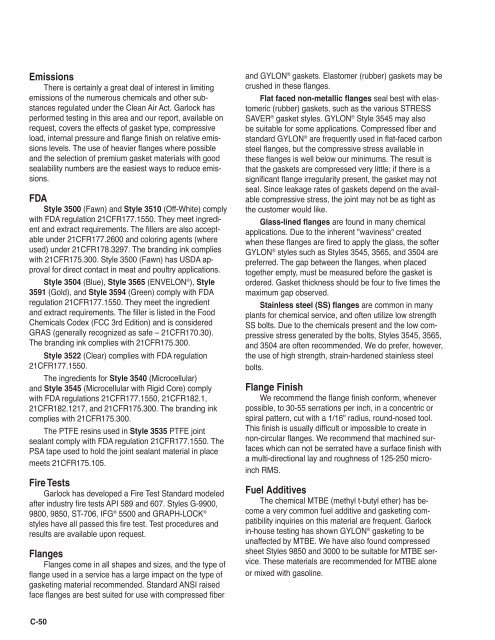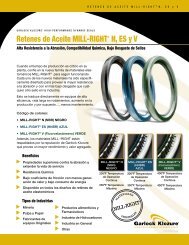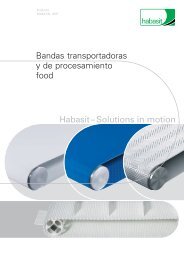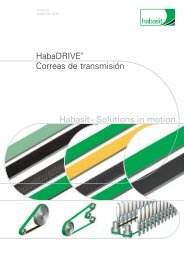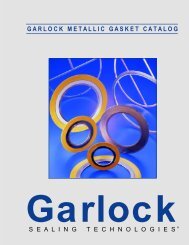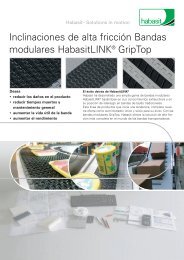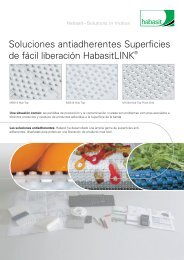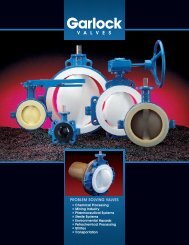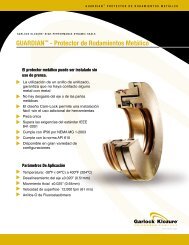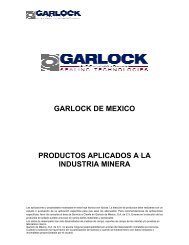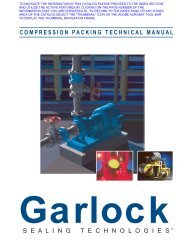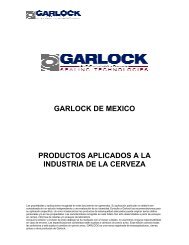Engineered Gasketing Products
Engineered Gasketing Products
Engineered Gasketing Products
- No tags were found...
You also want an ePaper? Increase the reach of your titles
YUMPU automatically turns print PDFs into web optimized ePapers that Google loves.
EmissionsThere is certainly a great deal of interest in limitingemissions of the numerous chemicals and other substancesregulated under the Clean Air Act. Garlock hasperformed testing in this area and our report, available onrequest, covers the effects of gasket type, compressiveload, internal pressure and flange finish on relative emissionslevels. The use of heavier flanges where possibleand the selection of premium gasket materials with goodsealability numbers are the easiest ways to reduce emissions.FDAStyle 3500 (Fawn) and Style 3510 (Off-White) complywith FDA regulation 21CFR177.1550. They meet ingredientand extract requirements. The fillers are also acceptableunder 21CFR177.2600 and coloring agents (whereused) under 21CFR178.3297. The branding ink complieswith 21CFR175.300. Style 3500 (Fawn) has USDA approvalfor direct contact in meat and poultry applications.Style 3504 (Blue), Style 3565 (ENVELON ® ), Style3591 (Gold), and Style 3594 (Green) comply with FDAregulation 21CFR177.1550. They meet the ingredientand extract requirements. The filler is listed in the FoodChemicals Codex (FCC 3rd Edition) and is consideredGRAS (generally recognized as safe – 21CFR170.30).The branding ink complies with 21CFR175.300.Style 3522 (Clear) complies with FDA regulation21CFR177.1550.The ingredients for Style 3540 (Microcellular)and Style 3545 (Microcellular with Rigid Core) complywith FDA regulations 21CFR177.1550, 21CFR182.1,21CFR182.1217, and 21CFR175.300. The branding inkcomplies with 21CFR175.300.The PTFE resins used in Style 3535 PTFE jointsealant comply with FDA regulation 21CFR177.1550. ThePSA tape used to hold the joint sealant material in placemeets 21CFR175.105.Fire TestsGarlock has developed a Fire Test Standard modeledafter industry fire tests API 589 and 607. Styles G-9900,9800, 9850, ST-706, IFG ® 5500 and GRAPH-LOCK ®styles have all passed this fire test. Test procedures andresults are available upon request.FlangesFlanges come in all shapes and sizes, and the type offlange used in a service has a large impact on the type ofgasketing material recommended. Standard ANSI raisedface flanges are best suited for use with compressed fiberand GYLON ® gaskets. Elastomer (rubber) gaskets may becrushed in these flanges.Flat faced non-metallic flanges seal best with elastomeric(rubber) gaskets, such as the various STRESSSAVER ® gasket styles. GYLON ® Style 3545 may alsobe suitable for some applications. Compressed fiber andstandard GYLON ® are frequently used in flat-faced carbonsteel flanges, but the compressive stress available inthese flanges is well below our minimums. The result isthat the gaskets are compressed very little; if there is asignificant flange irregularity present, the gasket may notseal. Since leakage rates of gaskets depend on the availablecompressive stress, the joint may not be as tight asthe customer would like.Glass-lined flanges are found in many chemicalapplications. Due to the inherent "waviness" createdwhen these flanges are fired to apply the glass, the softerGYLON ® styles such as Styles 3545, 3565, and 3504 arepreferred. The gap between the flanges, when placedtogether empty, must be measured before the gasket isordered. Gasket thickness should be four to five times themaximum gap observed.Stainless steel (SS) flanges are common in manyplants for chemical service, and often utilize low strengthSS bolts. Due to the chemicals present and the low compressivestress generated by the bolts, Styles 3545, 3565,and 3504 are often recommended. We do prefer, however,the use of high strength, strain-hardened stainless steelbolts.Flange FinishWe recommend the flange finish conform, wheneverpossible, to 30-55 serrations per inch, in a concentric orspiral pattern, cut with a 1/16" radius, round-nosed tool.This finish is usually difficult or impossible to create innon-circular flanges. We recommend that machined surfaceswhich can not be serrated have a surface finish witha multi-directional lay and roughness of 125-250 microinchRMS.Fuel AdditivesThe chemical MTBE (methyl t-butyl ether) has becomea very common fuel additive and gasketing compatibilityinquiries on this material are frequent. Garlockin-house testing has shown GYLON ® gasketing to beunaffected by MTBE. We have also found compressedsheet Styles 9850 and 3000 to be suitable for MTBE service.These materials are recommended for MTBE aloneor mixed with gasoline.C-50


